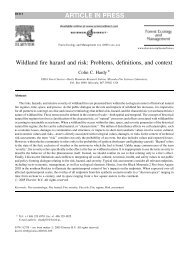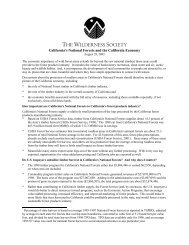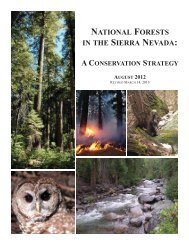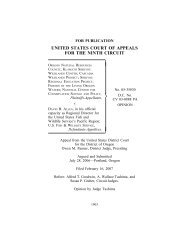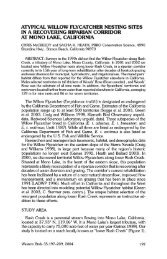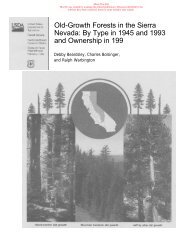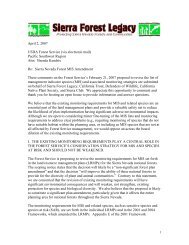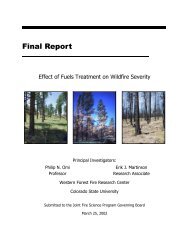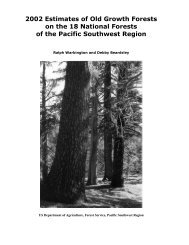1026VOLUME II, CHAPTER 36we can infer substantial impacts. Moreover, map and aerialpho<strong>to</strong>graph analyses of a large sample of <strong>Sierra</strong>n watershedsshow that virtually all riparian corridors are interrupted bygaps caused by such human activities such as construction ofroad or railroad crossings, human settlements, dewatering ofstreams, grazing, timber harvest, and mining. The largest gapsare caused by reservoirs, many of which exceed 0.5 km (0.3mi) in length, and which occur at a wide range of elevationsin the <strong>Sierra</strong> Nevada.Establishing riparian management zones (or “buffer strips”)of adequate width is probably the single most effective strategyfor protection and maintenance of the ecological valuesof riparian areas. Vegetation removal and ground disturbanceshould be prohibited in these zones, both <strong>to</strong> preserve the riparianhabitat itself and for its beneficial influence uponaquatic habitat. Although the width of these zones has mostcommonly been set arbitrarily, variable-width buffer strips(based on attributes of the river itself, the riparian community,and hill-slope gradients) can be established <strong>to</strong> better protectriparian resources.For channels below reservoirs, deliberate high flow releasescan be made <strong>to</strong> mimic the hydrologic effects of natural floodsin maintaining riparian vegetation. Res<strong>to</strong>ration of riparianhabitat, if based on careful analysis and on experience, canre-create many lost values <strong>to</strong> riparian and aquatic habitats.ACKNOWLEDGMENTSWe are indebted <strong>to</strong> Lynn Decker, Nancy Erman, Diana Jacobs,and Peter Moyle for their constructive criticism of an earlydraft of Kattelmann and Embury (1996) and for their insightfulsuggestions on how <strong>to</strong> approach the broad, complex, yetvery important <strong>to</strong>pic of riparian areas in the <strong>Sierra</strong> Nevada.Many others contributed substantially <strong>to</strong> the literature reviewor provided useful background information. The GeometricsDivision of the Engineering Department of the U.S. <strong>Forest</strong>Service Region V office in San Francisco contributed <strong>to</strong> theanalysis of riparian corridors on aerial pho<strong>to</strong>graphs, providingaccess <strong>to</strong> aerial pho<strong>to</strong>graphs and use of office space andequipment. The Bureau of Land Management resource officesin Folsom, and the district offices in Bakersfield and Bishop,also provided access <strong>to</strong> aerial pho<strong>to</strong>graphs. Sarah Marvin reviewedvideotapes of riparian corridors, held by the WaterResources Center Archives, University of California, Berkeley.Steve Beckwitt conducted the GIS analysis of watersheds.REFERENCESAbell, D. L., ed. 1989. Proceedings of the California riparian systemsconference: Protection, management, and res<strong>to</strong>ration for the 1990s.General Technical Report PSW-110. Berkeley: U.S. <strong>Forest</strong> Service,Pacific Southwest <strong>Forest</strong> and Range Experiment Station.Armour, C. L., D. A. Duff, and W. Elmore. 1991. The effects of lives<strong>to</strong>ckgrazing on riparian and stream ecosystems. Fisheries 16 (1): 7–11.Averill, C. V. 1946. Placer mining for gold in California. Bulletin 135.San Francisco: California Division of Mines.Beesley, D. 1996. Reconstructing the landscape: An environmentalhis<strong>to</strong>ry, 1820–1960. In <strong>Sierra</strong> Nevada Ecosystem Project: <strong>Final</strong> <strong>report</strong><strong>to</strong> Congress, vol. II, chap. 1. Davis: University of California, Centersfor Water and Wildland Resources.Behnke, R. J., and R. F. Raleigh. 1979. Grazing and the riparian zone:Impact and management perspectives. General Technical Report WO-12. Washing<strong>to</strong>n, DC: U.S. <strong>Forest</strong> Service.Berg, N., K. Roby, and B. McGurk. 1996. Cumulative watershedeffects: Applicability of available methodologies <strong>to</strong> the <strong>Sierra</strong>Nevada. <strong>Sierra</strong> Nevada Ecosystem Project: <strong>Final</strong> <strong>report</strong> <strong>to</strong> Congress,vol. III. Davis: University of California, Centers for Water andWildland Resources.Bergman, D. L., and C. W. Sullivan. 1963. Channel changes on Sands<strong>to</strong>neCreek near Cheyenne, Oklahoma. C145-C148. Professional Paper 475-C. Washing<strong>to</strong>n, DC: U.S. Geological Survey.Bisson, P. A., R. E. Bilby, M. D. Bryant, C. A. Dolloff, G. B. Grette, R.A. House, M. L. Murphy, K. V. Koski, and J. R. Sedell. 1987. Largewoody debris in forested streams in Pacific Northwest: Past,present, and future. In Streamside management: <strong>Forest</strong>ry and fisheryinteractions, edited by E. O. Salo and T. W. Cundy, 143–90. Seattle:University of Washing<strong>to</strong>n, College of <strong>Forest</strong> Resources.Biswell, H. H. 1989. Prescribed burning in California wildlands vegetationmanagement. Berkeley: University of California Press.Booth, D. B. 1990. Stream-channel incision following drainage-basinurbanization. Water Resources Bulletin 26: 407–17.Brookes, A. 1988. Channelized rivers. Chichester, England: John Wiley.Brothers, T. S. 1984. His<strong>to</strong>rical vegetation change in the Owens Riverriparian woodland. In California riparian systems: Ecology,conservation, and productive management, edited by R. E. Warnerand K. M. Hendrix, 75–84. Berkeley and Los Angeles: Universityof California Press.Brown, G. W. 1969. Predicting temperatures on small streams. WaterResources Research 5: 68–75.California Department of Finance. 1990. Ranking of California citiesand counties. Report E-8. Sacramen<strong>to</strong>: Department of Finance,Demographic Research Unit.California Department of <strong>Forest</strong>ry and Fire Protection. 1996. Calwater.Database online. Sacramen<strong>to</strong>: California Environmental ResourceEvaluation System. Available from http://ceres.ca.gov/watershed/.California Office of Land Conservation. 1988. Farmland mapping andmoni<strong>to</strong>ring program: Farmland conversion <strong>report</strong> 1984–1986.Publication FM 88-01. Sacramen<strong>to</strong>: California Department ofConservation, Office of Land Conservation.———. 1990. Farmland mapping and moni<strong>to</strong>ring program: Farmlandconversion <strong>report</strong> 1986–1988. Publication FM 90-01. Sacramen<strong>to</strong>:California Department of Conservation, Office of LandConservation.———. 1992. Farmland mapping and moni<strong>to</strong>ring program: Farmlandconversion <strong>report</strong> 1988–1990. Publication FM 92-01. Sacramen<strong>to</strong>:California Department of Conservation, Office of LandConservation.California State Lands Commission. 1993. California’s rivers: A publictrust <strong>report</strong>. Sacramen<strong>to</strong>: California State Lands Commission.Campbell, C. J. 1970. Ecological implications of riparian vegetationmanagement. Journal of Soil and Water Conservation 25:49–52.
1027Status of Riparian HabitatCarlson, A., M. Chapel, A. Colborn, D. Craig, T. Flaherty, C. Marshall,D. Pratt, M. Reynolds, S. Tanguay, W. Thompson, and S.Underwood. 1991. Old growth and riparian habitat planningproject: Review of literature addressing wildlife and fish habitatrelationships in riparian and stream habitats. Unpublished <strong>report</strong>.U.S. <strong>Forest</strong> Service, Tahoe National <strong>Forest</strong>, Grass Valley, California.Chaney, E., W. Elmore, and W. S. Platts. 1993. Lives<strong>to</strong>ck grazing onwestern riparian areas. Eagle, ID: Information Center, Inc.Chapel, M., A. Carlson, D. Craig, T. Flaherty, C. Marshall, M.Reynolds, D. Pratt, L. Pyshora, S. Tanguay, and W. Thompson. 1992.Recommendations for managing late-seral-stage forest andriparian habitats on the Tahoe National <strong>Forest</strong>. Unpublished <strong>report</strong>.U.S. <strong>Forest</strong> Service, Tahoe National <strong>Forest</strong>, Nevada City, California.Clark, W. B. 1970. Gold districts of California. Bulletin 193. San Francisco:California Division of Mines and Geology.Costick, L. 1996. Indexing current watershed conditions using remotesensing and GIS. In <strong>Sierra</strong> Nevada Ecosystem Project: <strong>Final</strong> <strong>report</strong> <strong>to</strong>Congress, vol. II, chap. 54. Davis: University of California, Centersfor Water and Wildland Resources.Cross, S. D. 1988. Riparian systems and small mammals and bats. InStreamside management: Riparian wildlife and forestry interactions,edited by K. Raedeke. Seattle: University of Washing<strong>to</strong>n, Centerfor Streamside Studies.Cummins, K. W., M. A. Wilzbach, D. M. Gates, J. B. Perry, and W. B.Taliaferro. 1989. Shredders and riparian vegetation. BioScience 39(1): 24–30.Diggles, M. F., J. R. Rytuba, B. C. Moring, C. T. Wrucke, D. P. Cox, S.Luding<strong>to</strong>n, R. P. Ashley, W. J. Pickthorn, C. T. Hillman, and R. J.Miller. 1996. Geology and minerals issues. In <strong>Sierra</strong> NevadaEcosystem Project: <strong>Final</strong> <strong>report</strong> <strong>to</strong> Congress, vol. II, chap. 18. Davis:University of California, Centers for Water and WildlandResources.Duane, T. P. 1996. Human settlement, 1850–2040. In <strong>Sierra</strong> NevadaEcosystem Project: <strong>Final</strong> <strong>report</strong> <strong>to</strong> Congress, vol. II, chap. 11. Davis:University of California, Centers for Water and WildlandResources.Dudley, T. L., and W. E. Dietrich. 1995. Effects of cattle grazingexclosures on the recovery of riparian ecosystems in the southern<strong>Sierra</strong> Nevada. Technical Completion Report UCAL-WRC-W-831.Davis: University of California, Water Resources Center.Dudley, T., and M. Embury. 1995. Non-indigenous species inwilderness areas: The status and impacts of lives<strong>to</strong>ck and gamespecies in designated wilderness in California. Oakland: PacificInstitute for Studies in Development, Environment, and Security.Dunford, E. G., and P. W. Fletcher. 1947. Effect of removal ofstreambank vegetation upon water yield. Transactions of theAmerican Geophysical Union 28: 105–10.Dunne, T., and L. B. Leopold. 1978. Water in environmental planning.San Francisco: W. H. Freeman.Elmore, W., and R. L. Beschta. 1987. Riparian areas: Perceptions inmanagement. Rangelands 9 (6): 260–65.Erman. D. C. 1992. His<strong>to</strong>rical background of long-term diversion ofthe Little Truckee River. In The His<strong>to</strong>ry of Water: Eastern <strong>Sierra</strong>Nevada, Owens Valley, and White Mountains, edited by C. A. Hall,V. Doyle-Jones, and B. Widawski, 415–27. Los Angeles: Universityof California, White Mountain Research Station.Erman, D. C., and D. Mahoney. 1983. Recovery after logging in streamswith and without bufferstrips in northern California. Contribution 186.Berkeley: University of California, Water Resources Center.Erman, D. C., J. D. Newbold, and K. B. Roby. 1977. Evaluation ofstreamside bufferstrips for protecting aquatic organisms. Contribution165. Davis: University of California, Water Resources Center.Erman, N. 1984. The use of riparian systems by aquatic insects. InCalifornia riparian systems: Ecology, conservation, and productivemanagement, edited by R. E. Warner and K. Hendrix, 177–82.Berkeley and Los Angeles: University of California Press.———. 1996. Status of aquatic invertebrates. In <strong>Sierra</strong> Nevada EcosystemProject: <strong>Final</strong> <strong>report</strong> <strong>to</strong> Congress, vol. II, chap. 35. Davis:University of California, Centers for Water and WildlandResources.Federal Energy Regula<strong>to</strong>ry Commission. 1986. <strong>Final</strong> environmentalimpact statement, Owens River Basin: Seven hydroelectric projects,California. Docket no. EL85-19-102. Washing<strong>to</strong>n DC: Federal EnergyRegula<strong>to</strong>ry Commission, Office of Hydropower Licensing.Franklin, J. F., and J. A. Fites-Kaufmann. 1996. Analysis of latesuccessional forests. In <strong>Sierra</strong> Nevada Ecosystem Project: <strong>Final</strong> <strong>report</strong><strong>to</strong> Congress, vol. II, chap. 21. Davis: University of California, Centersfor Water and Wildland Resources.Furniss, M. J., T. D. Roelefs, and C. S. Yee. 1991. Road constructionand maintenance. In Influences of forest and rangeland managemen<strong>to</strong>n salmonid fishes and their habitats, edited by W. R. Meehan, 297–323. Special Publication 19. Bethesda, MD: American FisheriesSociety.Gilbert, G. K. 1917. Hydraulic-mining debris in the <strong>Sierra</strong> Nevada.Professional Paper 105. Washing<strong>to</strong>n, DC: U.S. Geological Survey.Gill, C. J. 1970. The flooding <strong>to</strong>lerance of woody species—A review.<strong>Forest</strong>ry Abstracts 31: 671–88.Graber, D. 1996. Status of terrestrial vertebrates. In <strong>Sierra</strong> NevadaEcosystem Project: <strong>Final</strong> <strong>report</strong> <strong>to</strong> Congress, vol. II, chap. 25. Davis:University of California, Centers for Water and WildlandResources.Grant, G. 1988. The RAPID technique: A new method for evaluatingdownstream effects of forest practices on riparian zones. GeneralTechnical Report PNW-220. Corvallis, OR: U.S. <strong>Forest</strong> Service,Pacific Northwest <strong>Forest</strong> and Range Experiment Station.Greene, L. W., 1987. Yosemite: The park and its resources; A his<strong>to</strong>ry of thediscovery, management and physical development of Yosemite NationalPark, California. San Francisco: National Park Service.Gregory, S. V., F. J. Swanson, W. A. McKee, and K. W. Cummins. 1991.An ecosystem perspective of riparian zones. BioScience 41:540–51.Griggs, F. T., V. Morris, and E. Denny. 1994. Five years of valley oakriparian forest res<strong>to</strong>ration. Fremontia 22:13–17.Groeneveld, D. P., and D. Or. 1994. Water table induced shrubherbaceouseco<strong>to</strong>ne: hydrologic management implications. WaterResources Bulletin 30 (5): 911–20.Hagan, R. M., and E. B. Roberts. 1973. Ecological impacts of waters<strong>to</strong>rage and diversion projects. In Environmental quality and waterdevelopment, edited by C. R. Goldman, J. McEvoy, and P. J.Richerson, 196–215. San Francisco: W. H. Freeman.Harris, R. R., C. A. Fox, and R. Risser. 1987. Impacts of hydroelectricdevelopment on riparian vegetation in the <strong>Sierra</strong> Nevada region,California, USA. Environmental Management 11 (4): 519–27.Herbst, D., and R. Knapp. 1995. Biomoni<strong>to</strong>ring of rangeland streamsunder differing lives<strong>to</strong>ck grazing practices. Bulletin of the NorthAmerican Benthological Society 14 (1): 176.Hesse, L. W., and W. Sheets. 1993. The Missouri River hydrosystem.Fisheries 18 (5): 5–14.
- Page 1 and 2: G. MATHIAS KONDOLFDepartment of Lan
- Page 4 and 5: 1012VOLUME II, CHAPTER 36TABLE 36.1
- Page 6 and 7: 1014VOLUME II, CHAPTER 36TABLE 36.3
- Page 8 and 9: 1016VOLUME II, CHAPTER 36Elevation
- Page 10 and 11: 1018VOLUME II, CHAPTER 36FIGURE 36.
- Page 12 and 13: 1020VOLUME II, CHAPTER 36FIGURE 36.
- Page 14 and 15: 1022VOLUME II, CHAPTER 36Frequency
- Page 16 and 17: 1024VOLUME II, CHAPTER 36conditions
- Page 20 and 21: 1028VOLUME II, CHAPTER 36Hicks, T.
- Page 22: 1030VOLUME II, CHAPTER 36Schimer, F



